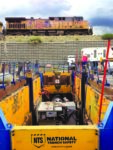Items Tagged with 'Hazard identification'
ARTICLES
‘Seeing’ safety in a new way
Visual literacy can help identify hidden work hazards, experts say
Read MoreHAZARD MITIGATION
Job Hazard Analysis/Job Safety Analysis
Procedure goes by various names but reaps many benefits, proponents say
Read More7 common workplace safety hazards
National Safety Council consultants identify what they see repeatedly when auditing worksites
Read More










